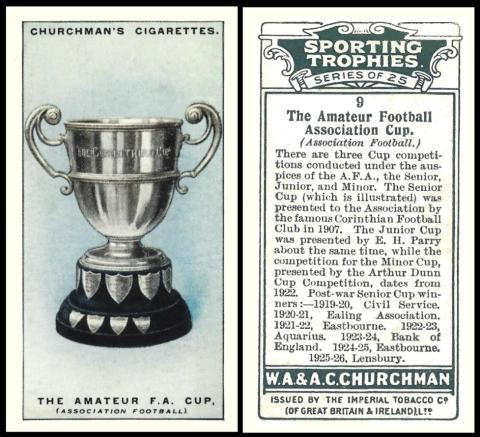
So for our first clue we had a cup, but using a trophy to represent the word "cup" so as to make us think of a tea cup. Which you may think has to be the main ingredient in any tea ceremony, but not necessarily, for in China they use bowls, not cups. And they do not use a teapot either.
This cup is no longer played for, because, in 1974, after a long history of having this special cup for amateur clubs, the Football Association decided not to abandon awarding a cup, but instead to abolish the official status of amateur football.
But let us go back to the start, in 1892. At that time football was a bit of a free for all, and professional and amateur teams played each other. This meant that the professionals always won everything, and so, in 1892, Sheffield F.C. suggested that in the interests of fair sport there ought to be a cup for the best amateur team. They even offered to buy the cup. But the Football Association said no.
However, in less than a year they had changed their mind and set about organising an amateur football competition of their own. They set up a committee and a sub-committee, chaired by N.L. Jackson, who had set up Finchley F.C. in 1877 and been elected to the committee of the Football Association in 1881. At the time of the first stirrings of this amateur league, he was with Corinthian F.C. a club he founded in 1882.
He bought the trophy, presumably the one on this card, for £30, and the first tournament, starting with eighty-one teams, was held towards the end of 1893. That was won by Old Carthusians, a team comprising past and present students of Charterhouse School. They may be a team that few people have heard of, but they had form, as they had actually won the F.A.Cup in 1881.
In the match for the inaugural Amateur Football Association Cup, they defeated a team called Casuals, which was also made up of students from Charterhouse, as well as Eton, and Westminster, and other Universities and public schools. Oddly these two teams merged in 1939 to form the Corinthian-Casuals, a club which is still playing to this day.
As far as a few statistics, the most successful team was Bishop Auckland, who won it ten times, starting in 1895, and were runners up eight times. They last won in 1957, by which time the final was being held at Wembley Stadium, where it had moved in 1949, before that it was just played on any neutral ground.
And when this card was issued it was held by Leyton, who had beaten Barking Town in 1927 and Cockfield in 1928.
The last name on the trophy was Bishop`s Stortford, who beat Ilford in the final final, in 1974.
In 1974 the former contestants of this trophy were given a choice of either playing for the F.A. Trophy, which had first appeared in 1969, and was for teams which were not part of the Football League but which were professional and not amateur. Obviously not all the teams wanted to turn professional though, and that led to the creation of the F.A. Vase.
As to our set, it has a sibling, of larger size, which we feature as our Card of the Day for June 28, 2025. These both appear in our original Churchman reference book (RB.10), published in 1948, as :
- 131. April 1927. 25 SPORTING TROPHIES (titled series). Size 2 11/16" x 1 7/16" or 67 x 36 m/m. Numbered 1-25. Fronts printed by letterpress, 4-colour half tone process. Backs in dark green, with descriptions. Printed by Mardon, Son & Hall.
- 132. May 1927. 12 SPORTING TROPHIES. Similar format to (131) but size 3 5/16" x 2 9/20" or 80 x 62 m/m
Our original World Tobacco Issues Index shortens this to
- SPORTING TROPHIES. Nd. ... C82-80
A. Small (25)
B. Large (12)
And this text remains the same, though all on one line, in our updated version - though there is a new card code, of C504-655
